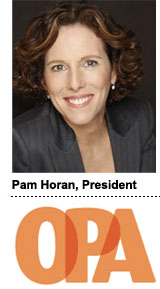 The NewFront – the digital world’s answer to the TV upfront marketplace – wrapped up last week with a number of high-profile, extravagant showcases of new content from Yahoo, Aol, The Weather Channel and others. At the same time, programmatic buying methods have adopted traditional models of locking in guaranteed sales, months ahead of schedule.
The NewFront – the digital world’s answer to the TV upfront marketplace – wrapped up last week with a number of high-profile, extravagant showcases of new content from Yahoo, Aol, The Weather Channel and others. At the same time, programmatic buying methods have adopted traditional models of locking in guaranteed sales, months ahead of schedule.
But can digital, with its near-infinite inventory and lack of a fall season or defined day parts, successfully emulate these traditional models?
AdExchanger checked in with Pam Horan, president of the Online Publishers Association, for her take on what’s in front of digital sellers these days.
AdExchanger: What do you think of the way the NewFront period has evolved? Is it meaningful in terms of becoming a marketplace that actually generates revenue, in the way that the upfront is for television?
PAM HORAN: Making a direct comparison between the NewFront and television upfronts is always going to be difficult simply because the seasonal structure of TV schedules and the nature of their inventory is so different. I think the NewFront has played an important role in highlighting the depth and breadth of digital content that advertisers can partner with. The impact of it is spread out more than television’s upfront because digital is always generating new content and doesn’t have a “fall season” to front-load.
What’s the OPA’s stance on the increasing activity by browsers like Microsoft’s Internet Explorer and Mozilla’s Firefox to block cookies by default? Could this actually benefit publishers, since most major outlets (such as OPA members) primarily rely on direct sales and contextual/adjacent ads anyway?
Ultimately, this is about fostering a healthy environment where consumers feel safe online. In its decision to block third-party cookies by default, Mozilla is differentiating between sites that have direct first-party relationships with consumers and those who don’t— an approach I think is more likely to meet with users’ expectations. We are encouraged by the work that the DAA and the W3C are doing to further develop ecosystem-wide solutions so that there is a consistent way for consumers to understand their options regarding tracking online.
You are correct that direct sales, which offer high touch programs for marketers to create enhanced brand experiences along with contextual based advertising, continue to be the backbone of premium content revenue. OPA publishers are creating content that people love and visit every day, and advertising brands benefit from those deep connections.
After resisting programmatic ad sales methods, many publishers like Condé Nast, Hearst, Time Inc. and others have embraced tools like private exchanges as a way of managing exchange-based and real-time bidding ad sales. Do you provide any guidance to publishers trying to decide whether or not to use these tools?
Over the past year, many publishers have established private exchanges while others have begun to place inventory into the open exchange marketplace. As the technology is still new, the publishers are doing a lot of testing and adjusting as they learn what is working and [what is] not for their individual business.
One of the key assets that OPA members have is a rich set of audience data; really this is premium data that goes hand in hand with premium content. This premium data allows for the kind of rich segmented targeting that marketers and their agencies are interested in, allied with the perfect content environment. Ultimately, publishers will look to work with ad tech partners that deliver the tools and insights to support their data initiatives. Not all the companies powering exchanges today seem to be doing so.
Every year is always billed as the “year of mobile,” but we still always hear that consumers’ time spent is way ahead of advertisers’ spending. How meaningful is mobile advertising for OPA members these days? And is there a worry that publishers will lose money with fewer ads per page?
We’ve seen members like Gannett take an aggressive “mobile first” strategy to optimize their sites as more and more consumers are using their smartphones and tablets to access news, information and entertainment online. Advertiser money will follow the consumer. This kind of a lag mirrors what we’ve seen in the shift of advertising dollars from offline to online. Mobile has also opened up the opportunity to offer dynamic local solutions, which publishers are using to serve relevant content along with compelling advertising experiences.
Ecommerce has become a more important idea for publishers as the need for additional revenue streams becomes clear. What’s your sense of publishers’ ability to take advantage of the mainstreaming of shopping via smartphones and PCs?
The right kind of ecommerce experience can complement and enhance the consumer experience overall. Our members create the content consumers turn to, rely on, and are passionate about, day in and day out; this is an ideal environment to bring the point of purchase that much closer. Publishers are formulating interesting offers that are highly relevant to their specific audiences and could become a significant revenue stream to compliment advertising.












